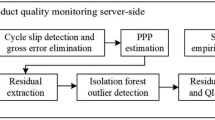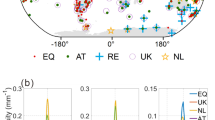Abstract
Due to errors, accuracy of Global Positioning System is not so high. Therefore, the Real Time Differential Global Poisoning System (RTDGPS) which is based on the successive transmission message of RTCM protocol, is using in real-time applications. Stability and accuracy of the system, significantly depends to a fast transmission of correction messages. These messages come from the reference station to the user stations and affected by the errors related to each satellite. Receiving correction factors which are transmitted by the reference station are facing with time-lag problem, which can increase the error of the RTDGPS. To overcome this problem, prediction algorithms are used. In this research, support vector machine (SVM) model is used to predict the pseudo range correction. Unfortunately, the practical use of SVM is limited because the quality of SVM models depends on a proper setting of SVM and SVM kernel parameters. Therefore, to determine the main parameters of the SVM, both particle swarm optimization (PSO) and genetic algorithm (GA), as two optimization techniques, are used. The proposed methodology has been implemented by a 6-s predicts time step. Simulations showed that the accuracy of GA–SVM and PSO–SVM are equal to 0.186 and 0.154, respectively.

















Similar content being viewed by others
Abbreviations
- ANN:
-
Artificial neural network
- ARMA:
-
Autoregressive moving average
- ERM:
-
Empirical risk minimization
- GA:
-
Genetic algorithm
- GPS:
-
Global positioning system
- GS:
-
Grid search
- MCM:
-
Model complexity minimization
- NMEA:
-
National Marine Electronics Association
- PR:
-
Pseudo-range
- PRC:
-
Pseudo range correction
- PSO:
-
Particle swarm optimization
- RBF:
-
Radial basis function
- RRC:
-
Range rate correction
- RTCM:
-
Radio Technical Commission for Maritime Services
- RTDGPS:
-
Real Time Differential Global Poisoning System
- SVM:
-
Support vector machine
- SVR:
-
Support vector regression
- TTL:
-
Transistor–transistor logic
References
P. K. Enge, The Global Positioning System: Signals, measurements, and performance, International Journal of Wireless Information Networks, Vol. 1, No. 2, pp. 83–105, 1994.
Sh. Chuang, Y. Wenting, S. Weiwei, L. Yidong, Y. yibin, Z. Rui, GLONASS pseudorange inter-channel biases and their effects on combined GPS/GLONASS precise point positioning, GPS Solutions, Vo. 17, No. 4, pp. 439-451, 2013.
H. Bock, R. Dach, Y. Yoon and O. Montenbruck, GPS clock correction estimation for near real-time orbit determination Applications, Aerospace Science and Technology, Vol. 13, No. 7, pp. 415–422, 2009.
M. Mohasseb, A. Rabbany, O. Alim and R. Rashad, DGPS correction prediction using artificial neural networks, The Journal of Navigation, Vol. 60, No. 2, pp. 291–301, 2007.
J. Zhang, K. Zhang, R. Grenfell and R. Deakin, GPS satellite velocity and acceleration determination using the broadcast ephemeris, The Journal of Navigation, Vol. 59, No. 2, pp. 293–305, 2006.
M. R. Mosavi, Comparing DGPS Corrections Prediction using Neural Network, Fuzzy Neural Network, and Kalman Filter, GPS Solutions, Vol. 10, No. 2, pp. 97–107, 2006.
Y. Zhang and Ch G Bartone, A real-time meteorological-based troposphere (RMT) correction with integrity bound for long baseline DGPS, GPS Solutions, Vol. 9, No. 4, pp. 255–272, 2005.
M. R. Mosavi, Wavelet Neural Network for Corrections Prediction in Single-Frequency GPS Users, GPS Solutions, Vol. 33, No. 2, pp. 137–150, 2011.
T. Anagnostopoulos, Ch Anagnostopoulos and S. Hadjiefthymiade, an Adaptive Machine Learning Algorithm for Location Prediction, International Journal of Wireless Information Networks, Vol. 18, No. 2, pp. 88–99, 2001.
M. H. Refan, A. Dameshghi and M. Kamarzarrin, Real Time Pseudo-Range Correction Predicting by a Hybrid GASVM Model in Order to Improve RTDGPS Accuracy, Iranian Journal of Electrical & Electronic Engineering., Vol. 9, No. 4, pp. 215–223, 2013.
M. H. Refan and A. Dameshghi, RTDGPS Implementation by Online Prediction of GPS Position Components Error Using GA-ANN Model, Journal of Electrical and Computer Engineering Innovations, Vol. 1, No. 1, pp. 43–50, 2013.
M. R. Mosavi and H. Nabavi, Improving DGPS Accuracy using Neural Network Modeling, Australian Journal of Basic and Applied Sciences, Vol. 5, No. 5, pp. 848–856, 2011.
D. Jwo, T. Lee and Y. W. Tseng, ARMA Neural Networks for Predicting DGPS Pseudo range Correction, The journal of navigation, Vol. 57, No. 2, pp. 275–286, 2004.
M. H. Refan, A. Dameshghi and M. Kamarzarrin, Improving RTDGPS accuracy using hybrid PSOSVM prediction model, Aerospace Science and Technology, Vol. 37, pp. 55–69, 2014.
M. H. Refan, A. Dameshghi and M. Kamarzarrin, Utilizing Hybrid Recurrent Neural Network and Genetic Algorithm for Predicting the Pseudo-Range Correction Factors to Improve the Accuracy of RTDGPS, Gyroscope and Navigation., Vol. 6, No. 3, pp. 197–206, 2015.
A. Indriyatmoko, T. Y. J. Kang, G. I. Lee, Y. B. Jee and J. Kim, Artificial Neural Network for Predicting DGPS Carrier Phase and Pseudo-Range Correction, GPS Solutions, Vol. 12, No. 4, pp. 237–247, 2008.
V.N. Vapnik, the Nature of Statistical Learning Theory, Springer Verlag, 1995.
R. Yuan and B. Guangchen, Determination of Optimal SVM Parameters by Using GAPSO, journal of computers, Vol. 5, No. 8, pp. 1160–1168, 2010.
W. Yongli, N. Dongxiao and M. Xiaoyong, Optimizing of SVM with Hybrid PSO and Genetic Algorithm in Power Load Forecasting, journal of networks, Vol. 5, No. 10, pp. 1192–1198, 2010.
A. Selakov, D. Cvijetinović, L. Milović, S. Mellon and D. Bekut, Hybrid PSO–SVM method for short-term load forecasting during periods with significant temperature variations in city of Burbank, Applied Soft Computing, Vol. 16, pp. 80–88, 2014.
P. P. Feng, H. W. Chiang and L. Y. Shen, Determining Parameters of Support Vector Machines by Genetic Algorithms-Applications to Reliability Prediction, International Journal of Operations Research, Vol. 2, No. 1, pp. 1–7, 2005.
L. S. Wei, Y. K. Ching, C. S. Chieh and L. Z. Jung, Particle swarm optimization for parameter determination and feature selection of support vector machines, Expert Systems with Applications, Vol. 35, No. 4, pp. 1817–1824, 2008.
Empirical Observation in Iran, A. Abdollahi, H. Aryaei Nejad, A. Nodehi, Genetic Algorithm and Support Vector Machine as Tools for Predicting Corporate Failure and Success, American Journal of Scientific Research, Vol. 55, pp. 119–127, 2012.
B. Park, J. Kim and C. Kee, RRC Unnecessary for DGPS Messages, IEEE transactions on aerospace and electronic systems, Vol. 42, No. 3, pp. 1149–1160, 2006.
P. Misra, P. Enge, Global Positioning System–Signals, Measurements, and Performance, Ganga-Jamura Press, 2001, 132-196.
M. Berber, A. Ustun and M. Yetkin, Comparison of accuracy of GPS techniques, Measurement, Vol. 45, No. 7, pp. 1742–1746, 2012.
C. W. Hsu and C. J. Lin, A simple decomposition method for support vector machine, Mach. Learn, Vol. 46, No. 1, pp. 219–314, 2002.
P. Samui, Support vector machine applied to settlement of shallow foundations on cohesion less soils, Computers and Geotechnics, Vol. 35, No. 3, pp. 419–427, 2008.
C. Gao, E. Bompard, R. Napoli and H. Cheng, Price forecast in the competitive electricity market by support vector machine, Physica, A: Statistical Mechanics and its Applications, Vol. 382, No. 1, pp. 98–113, 2007.
L. J. Cao and F. E. H. Tay, Support vector machine with adaptive parameters in financial time series forecasting, IEEE Transactions on Neural Network, Vol. 14, No. 6, pp. 1506–1518, 2003.
C. J. C. Burgers, A tutorial on support vector machines for pattern recognition, Data Mining and Knowledge Discovery, Vol. 2, No. 2, pp. 121–167, 1998.
X. Zhanga and E. A. Amin, Highly predictive support vector machine (SVM) models for anthrax toxin lethal factor (LF) inhibitors, Journal of Molecular Graphics and Modelling, Vol. 63, pp. 22–28, 2016.
H. Drucker, C. Burges, L. Kaufman, A. Smola and V. Vapnik, Support Vector Regression Machines,9 ed., MIT PressCambridge, 1997. pp. 155–161.
P. Minqiang, Z. Dehuai and X. U. Gang, Temperature Prediction of Hydrogen Producing reactor using svm regression with pso-svm, journal of computers, Vol. 5, No. 3, pp. 388–393, 2010.
M. Nizam, A. Mohamed, M. Al-Dabbagh and A. Hussain, Using Support Vector Machine for Prediction Dynamic Voltage Collapse in an Actual Power System, World Academy of Science, Engineering and Technology, Vol. 41, pp. 710–715, 2008.
M. A. Mohandes, T. O. Halawani, S. Rehman and A. A. Hussain, Support vector machines for wind speed prediction, Renewable Energy, Vol. 29, No. 6, pp. 939–947, 2004.
P. J. García Nieto, E. García-Gonzalo, J. R. Alonso Fernández and C. Díaz Muñiz, A hybrid PSO optimized SVM-based model for predicting a successful growth cycle of the Spirulina platensis from raceway experiments data, Journal of Computational and Applied Mathematics, Vol. 291, No. 1, pp. 293–303, 2016.
Y. Wang, Y. Li, Q. Wang and Y. Lv, Computational identification of human long intragenic non-coding RNAs using a GA–SVM algorithm, Journal of Gene, Vol. 533, No. 1, pp. 94–99, 2014.
E. Pourbasheera, S. Riahi, M. R. Ganjali and P. Norouzi, Application of genetic algorithm-support vector machine (GA-SVM) for prediction of BK-channels activity, European Journal of Medicinal Chemistry, Vol. 44, No. 12, pp. 5023–5028, 2009.
i-Lotus GPS Products - M12 M User’s Guide. [Online]. Available: http://www.ilotus.com.sg/ m12m_navigation_oncore.
Author information
Authors and Affiliations
Corresponding author
Rights and permissions
About this article
Cite this article
Refan, M.H., Dameshghi, A. & Kamarzarrin, M. Real-Time Differential Global Poisoning System Stability and Accuracy Improvement by Utilizing Support Vector Machine. Int J Wireless Inf Networks 23, 66–81 (2016). https://doi.org/10.1007/s10776-016-0295-2
Received:
Accepted:
Published:
Issue Date:
DOI: https://doi.org/10.1007/s10776-016-0295-2




